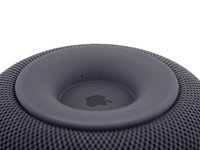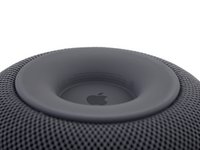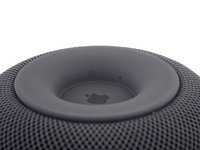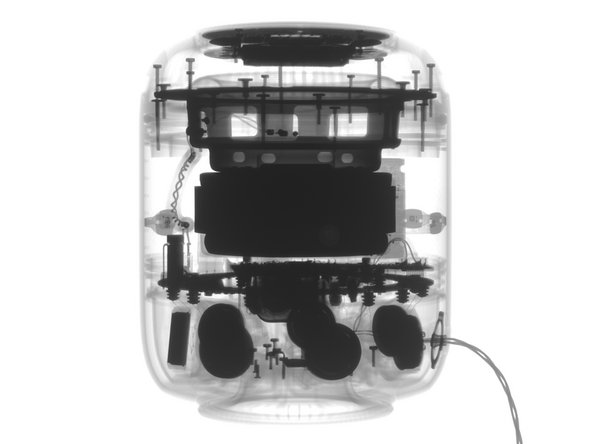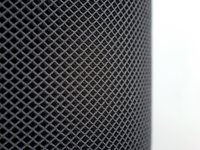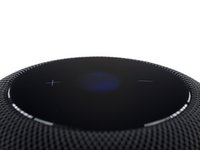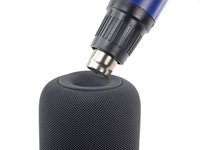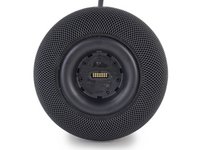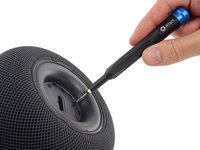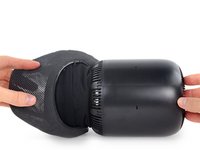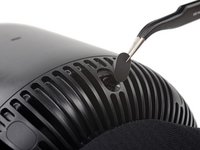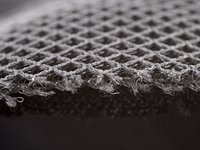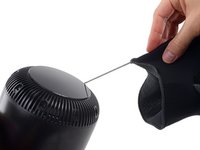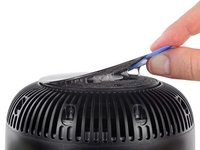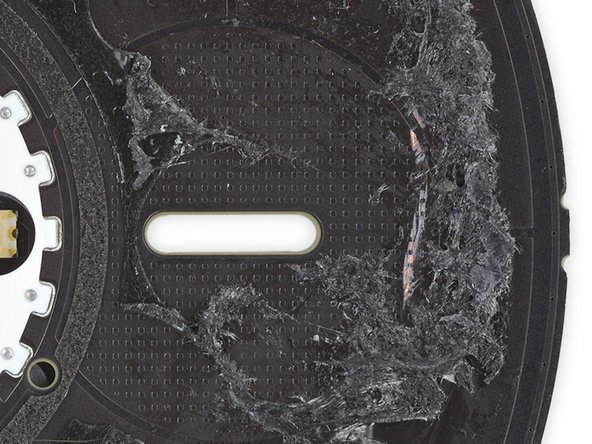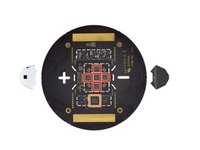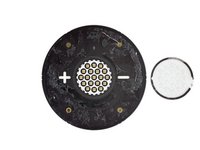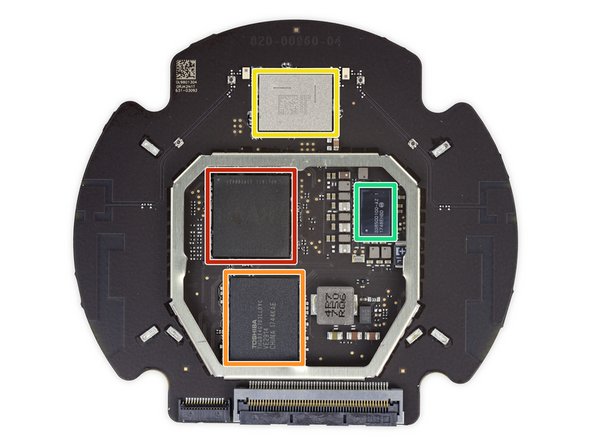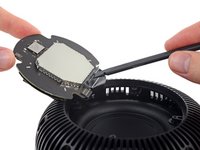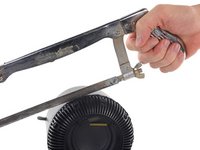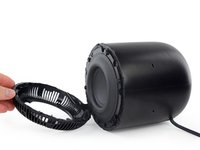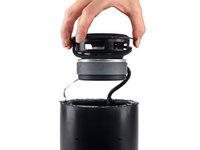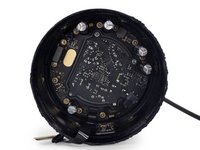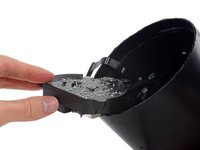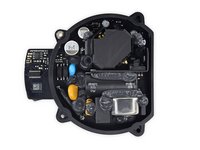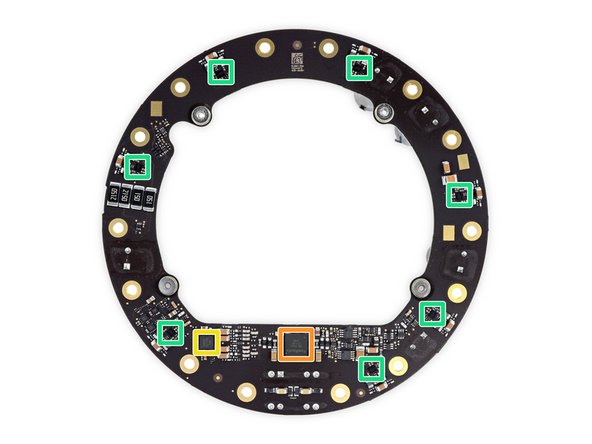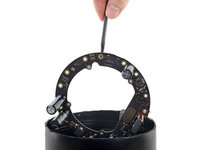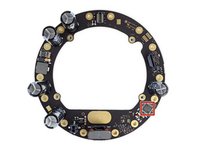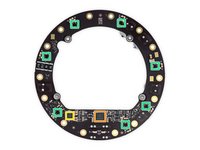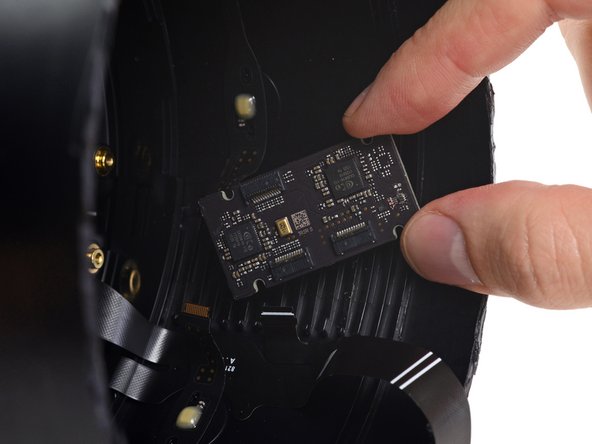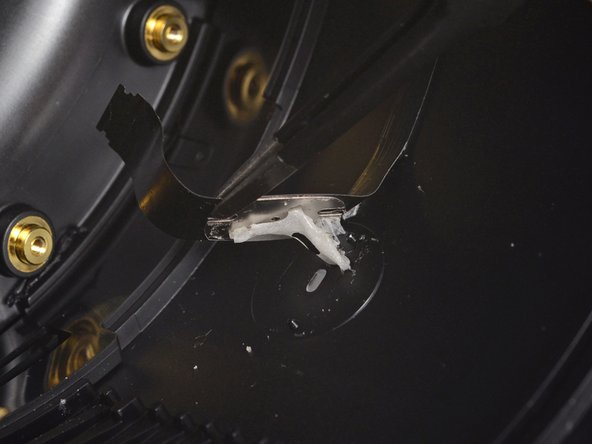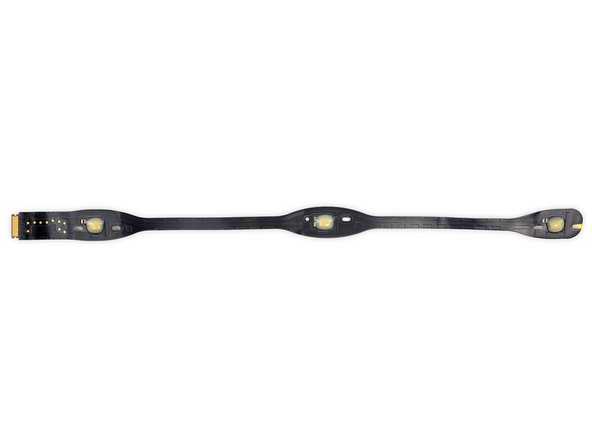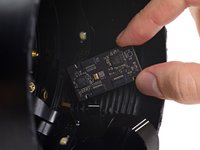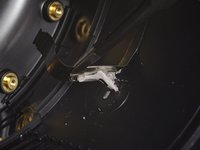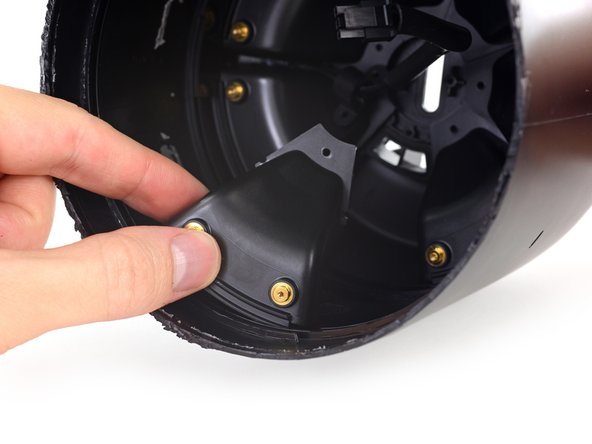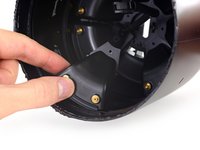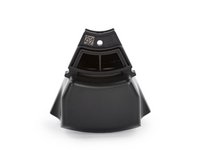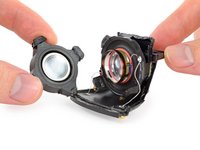Introduzione
L'amato assistente vocale di Apple è ritornato questa volta sotto forma di un rotolo di carta igienica Mac Pro con la giacca. Siri ora può (tentare di) rispondere alle tue domande con un suono ad alta fedeltà a 360°. Come ha fatto Apple a far stare tutto questo gran suono in uno spazio così piccolo, e perché ci ha messo tanto a farlo? Per scoprirlo, dobbiamo solo provare ad aprirlo!
Ehi Siri, dove posso trovare altre notizie sugli smontaggi? Guarda su Facebook, Instagram e Twitter. Se vuoi che il tuo smontaggio ti venga consegnato personalmente, vai avanti e iscriviti alla nostra newsletter.
Cosa ti serve
Panoramica Video
-
-
Che genere di tecnologia Apple sta nascondendo qui dentro? Ecco quello che ci hanno raccontato:
-
Woofer da 4" ad alta escursione con uscita suono dall'alto
-
Sistema a 7 tweeter con tecnologia beamforming
-
Sistema a 6 microfoni con tecnologia beamforming
-
Microfono per basse frequenze per calibrazione del woofer in tempo reale
-
Interfaccia touch nella parte superiore
-
Wi-Fi 802.11ac con MIMO + Bluetooth 5.0
-
-
-
L'HomePod non è il più alto in questa gamma, ma è certamente il più inquietante.
-
In ogni caso, mantiene il fattore di forma più o meno cilindrico tipico degli smart speaker a 360°.
-
A parte le proporzioni tra altezza e diametro, la differenza più evidente è che, diversamente dall'Amazon Echo e dal Google Home, l'HomePod è dotato di un alimentatore integrato e di un cavo di alimentazione
nonrimovibile (lo è se tiri abbastanza forte).
-
-
-
Ci imbattiamo in un bel po' di informazioni legali stampate con grande discrezione sotto il piede:
-
Scritte per il rispetto delle regole FCC, dello smaltimento dell'e-waste e di regole USA, ma anche europee e australiane, nonostante il nostro modello abbia una spina (apparentemente) fissa di tipo americano, e una che sottolinea il doppio isolamento del dispositivo.
-
Un numero modello nuovo di zecca: A1639.
-
E una coppia di piccoli fori.
-
-
-
Come prossimo passo, diamo la nostra prima bella occhiata alla retina acustica 3D realizzata in un pezzo solo di Apple.
-
In cima all'HomePod abitano un'essenziale interfaccia touch (nel caso a Siri serva una pausa) e un indicatore a LED di aspetto piuttosto familiare.
-
Grazie ai raggi X di Creative Electron, diamo uno sguardo all'interno: sembra che qui ci siano dei magneti enormi (evidenziati dalle macchie nere).
-
-
-
La nostra intelligenza artificiale a raggi X ci ha fatto scoprire delle viti sotto il piede, quindi abbiamo concentrato il fuoco sull'adesivo che lo tiene. Solo dopo un'accesa sparatoria con la pistola termica siamo stati in grado di sollevare e togliere il piede.
-
Pur sapendo che ci sono sotto delle viti, ci aspettiamo il peggio, dopo tutto questo lavoro con la colla...
-
... Ma siamo sollevati nello scoprire che queste viti Torx amiche del riparatore sono pronte per essere svitate. Sotto il piede di colla c'è una porta a 14 pin, probabilmente usata per collaudare o programmare gli HomePods tramite Pogo Pins in fase di assemblaggio.
-
-
-
Si dà il caso che queste viti non siano nostre amiche come pensavamo. Dopo averle rimosse, la piastra inferiore di plastica bloccata dalle viti è... ancora bloccata. Sembra che la retina tenga giù la piastra di accesso.
-
Noi non vogliamo davvero tagliare questa retina, quindi facciamo scorrere un plettro lungo il bordo incollato della spugna e tiriamo fuori la piastra. Che cosa ne ricaviamo? Dell'altra plastica impregnablle che non porta da nessuna parte.
-
-
-
Probabilmente ci vuole qualcosa di affilato. Abbiamo fatto del nostro meglio per lasciare che la retina resti tutta in un pezzo, ma senza risultati. E va bene, non sarà la prima volta che dobbiamo tagliare degli strani tessuti.
-
Facendoci largo tagliando la spessa retina 3D che integra sottili fili metallici, troviamo un rivestimento interno secondario in tessuto.
-
Questo involucro più fine e flessibile è intrappolato sotto la parte superiore dell'HomePad, quindi al momento lo lasciamo al suo posto.
-
Per fortuna il case interno non è in un pezzo solo come la retina; scopriamo altre viti Torx nascoste sotto delle spinette (strane davvero) di gomma.
-
-
-
-
Ecco un beneficio del lavoro di cucito che abbiamo appena fatto: possiamo vedere di quale magica fibra è composta questa copertura.
-
Niente di magico, scopriamo che questa griglia flessibile è composta di due strati a rete nella parte superiore e inferiore che racchiudono tra loro dei minuscoli anellini metallici.
-
Ora che abbiamo tirato via la retina, vediamo che è percorsa da un cordoncino su tutta la larghezza! Forse questo significa che c'è un modo non distruttivo di raggiungere la parte superiore dell'HomePad?
-
-
-
Cercando un accesso, stacchiamo il coperchietto rivestito di colla e scopriamo altre viti che apparentemente non portano da nessuna parte.
-
Dopo aver usato dell' altro calore ed essere passati attraverso un' altra piastra collosa, troviamo un altro strato ancora più all'interno e finalmente troviamo qualcosa.
-
Sotto la porta numero tre, troviamo: una scheda ben schermata, un largo cavo a nastro e i punti di ancoraggio del cordoncino.
-
-
-
La rimozione della schermatura della scheda ci mostra gli artisti che danno vita allo spettacolo di luci sovrastante:
-
Driver LED Texas Instruments TLC 5971
-
System-on-Chip programmabile Cypress CY8C4245LQI-483
-
Il lato inverso della scheda ospita i LED e il diffusore che dà all'indicatore il suo look nebuloso.
-
La parte superiore della scheda (seconda foto) mostra uno schieramento ben organizzato di piccole sporgenze: probabilmente una griglia capacitiva,come nel Google Home, per registrare i tap e i tocchi con le dita sulla superficie soprastante.
-
-
-
Il prossimo disco estratto supporta gli elaborati punti di attracco per il cordoncino; dietro c'è la scheda logica principale.
-
Quanto ai chip, troviamo:
-
SoC Apple A8 APL1011 SoC (l'abbiamo già visto in precedenza, ma faceva un lavoro diverso), probabilmente accoppiato a 1 GB di RAM integrata sotto
-
16 GB di memoria flash NAND Toshiba THGBX4G7D2LLDYC
-
Modulo Wi-Fi/Bletooth USI 339S00450, probabilmente con un Broadcom BCM43572 intrappolato dentro
-
Apple/Dialog 338S00100-AZ PMIC
-
Interessante il fatto che il retro abbia alcune aree disabitate per componenti SMD, pochi chip e molte parti passive. Forse ci sono stati dei cambiamenti progettuali dell'ultima ora nello HomePod?
-
-
-
Ed eccoci qua, di fronte a una giunzione che sembra impenetrabile. Accendiamo il seghetto (e il nostro cutter a ultrasuoni) e stacchiamo l'obesissimo woofer.
-
Se il magnete di questo woofer sembra molto grande per un altoparlante di queste dimensioni, è perché lo è davvero. Le note basse più profonde e coinvolgenti dipendono dalla capacità dell'altoparlante di muovere molta aria.
-
-
-
Dopo esserci aperti la strada a colpi di lama e di leva in questo altoparlante-fortezza, raggiungiamo l'ostacolo finale: un anello filettato.
-
Siamo portati a concludere che, a un certo punto, l'HomePod potesse essere svitato per separare il componente controllo/woofer dall'unità tweeter/alimentazione.
-
Ma non ci rimaniamo troppo male per aver buttato giù la porta: giudicando dall'adesivo presente sulla faccenda del tubo, le filettature non sono fatte per l'utente finale: questa cosa è stata chiusa con la colla.
-
-
-
Lo strato successivo della nostra cipolla HomePod (o forse parfait?) È l'alimentazione in due parti, composta di un blocco interno che gestisce la conversione AC/DC e un anello esterno che distribuisce l'alimentazione a tutti gli otto speaker.
-
L'imponente hardware che gestisce la corrente alternata in ingresso è inondato di resina epossidica, probabilmente per impedire che le malefiche vibrazioni lo facciano a pezzi. L'alimentazione è inviata all'anello esterno tramite distanziali a vite conduttivi in stile MacBook Pro.
-
-
Attrezzo utilizzato in questo passaggio:Halberd Spudger$2.99
-
Ed eccoci alla parte due dell'alimentazione, lo
Stargatel'Halol'anello di distribuzione dell'alimentazione, preso all'amo. -
La parte esterna della nostra scheda di alimentazione intergalattica, ingombra di condensatori, ospita un MCU ARM STMicroelectronics STM32L051C8T7 a potenza ultrabassa.
-
Sull'altro lato, troviamo:
-
Amplificatore audio International Rectifier PowlRaudio 98-0431
-
4350C Y01742 TWN
-
E, attorno al perimetro, sette amplificatori audio Analog Devices SSM35158 - si direbbe che siano gli amplificatori individuali per i tweeters!
-
-
-
Stacchiamo a forza una piccola scheda dall'adesivo che la tiene aderente al cilindro e notiamo due chip ADC Conexant CX20810 ADC della Synaptics per il gruppo microfoni.
-
Non contenta, la scheda ha anche lei un proprio microfono, probabilmente il microfono a bassa frequenza per la calibrazione del woofer.
-
Torniamo al resto dei microfoni: sono alloggiati in due lunghe strisce da tre microfoni ciascuno. Ogni striscia è tenacemente incollata all'interno del case, con i microfoni posizionati su canali a forma di imbuto.
-
-
-
Tiriamo fuori dall'HomeBody un altro anello filettato e alla fine ecco
Biancaneve ei sette tweeter, completi di rispettivi distanziali a vite conduttivi. -
Giusto: questi distanziali dorati alimentano i tweeter.
-
Dando un'occhiata a una delle uscite, ne ricaviamo cattive sensazioni. O forse è il tweeter che è nervoso.
-
È ora di scatenare il cutter ultrasonico per stappare questa unità!
-
-
-
Una volta aperto il gruppo, possiamo osservare meglio il tweeter, con sfoghi e trombetta, che dà all'HomePod il suo sound "preciso".
-
Gli sfoghi sui lati del rocchetto della bobina mobile e i quattro fori nella parte posteriore del tweeter evitano che l'aria vada in pressione dietro la cupola del tweeter mentre questa si muove.
-
-
-
Ed eccoci con tutti i pezzi di questa abitazione Siri.
-
Sapete come Apple si è lanciata in queste cose? Ci è sfuggito qualche concetto? Fatecelo sapere nei commenti, mentre ci raccomandiamo di guardare il nostro video dello smontaggio su YouTube.
-
È finalmente ora di dare un punteggio di riparabilità. Ci sono molti fattori positivi ma, dato che la procedura d'apertura non è davvero reversibile, ci comporteremo di conseguenza nel punteggio.
-
- L'HomePod è solido come un carro armato. La durata nel tempo non dovrebbe essere un problema.
- La retina esterna, pur essendo in un pezzo solo, può essere staccata senza danneggiarla grazie a un malefico ma astuto cordino.
- Tutti i fissaggi a vite sono della varietà standard Torx: nessuna fastidiosa vite antiapertura.
- L'uso estremamente intelligente di distanziali a vite conduttivi evita la presenza di cataste di cavi tra gli strati multipli di componenti.
- Adesivi molto tenaci bloccano la copertura dell'interfaccia touch, il gruppo microfoni, il piede di gomma e (più fastidioso di tutti) il principale punto di accesso in cima al dispositivo, che pure sembrava pensato per essere svitato senza particolari problemi.
- Benché sembra che ci sia un metodo di accedere all'interno non distruttivo, noi non siamo riusciti a decodificarlo. Senza un manuale di riparazione, la posta di successo sono molto esili.
Considerazioni Finali
Punteggio Riparabilità


(10 è il più facile da riparare)
Un ringraziamento speciale a questi traduttori:
78%
Questi traduttori ci stanno aiutando ad aggiustare il mondo! Vuoi partecipare?
Inizia a tradurre ›
84Commenti sulla guida
Thanks guys, very interesting report!
The power cable is actually user removable and replaceable. You just have to pull on it *really* hard. https://www.youtube.com/watch?v=gjxILSOf...
Very good teardown! Thanks!
Apparently the AC cable is replaceable, yet not meant to be user-replaced: https://9to5mac.com/2018/02/10/remove-ho...
What is the DAC?













